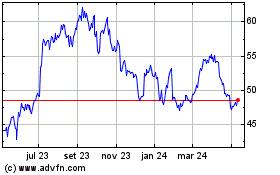BP Preparing For Top-Kill Operation, Mulling Alternatives
26 Maio 2010 - 1:42PM
Dow Jones News
BP Plc (BP, BP.LN) said Wednesday it is still conducting tests
to determine whether it can plug a massive U.S. Gulf of Mexico oil
spill using heavy drilling fluids, even as it continued to
alleviate the leak by siphoning oil from a gushing deepwater well
and pondering other options.
The company had previously signaled that it could start the
"top-kill" operation, which would flood the damaged Macondo well
with so-called drilling mud, on Wednesday morning. In an update
posted on its website early Wednesday, the company said that
diagnostics are still being carried out. The decision to move
forward will be made when the tests are completed, the company
said. The top-kill procedure could take up to two days to
implement, and it's unclear how long it will take for BP to find
out the results, the company said.
A BP spokesperson said that in the last 24 hours the company had
captured 2,600 barrels of crude through a tube connecting a surface
vessel to the damaged underwater infrastructure, slightly above the
average 2,000 barrels of crude a day siphoned since that effort
began last week. The leak, which began after the explosion and
sinking of the Transocean Ltd. (RIG) Deepwater Horizon drilling rig
more than a month ago, has an estimated rate of at least 5,000
barrels of oil a day.
The latest effort by the U.K.-based oil giant is being closely
watched by federal authorities and by the entire oil industry,
which faces an onslaught of regulation in the wake of the spill,
one of the worst ever seen in the U.S.
At a shareholders' meeting in Dallas on Wednesday, Exxon Mobil
Corp. (XOM)'s Chief Executive Rex Tillerson said that Exxon, the
world's largest publicly-traded oil company, continues to provide
assistance to BP in dealing with the disaster. "We are eager to
support efforts to determine how such an incident can be prevented
in the future," he said.
Chevron Corp. (CVX) Chief Executive John Watson said at his
company's shareholder meeting in Houston on Wednesday that the
industry is going to learn "a great deal" out of the spill.
"If there's something we have to adopt, we will adopt it," he
said.
BP said that if the top-kill operation fails, it will move a
containment system over the spill to try to capture the oil. To do
that, the company will first have to remove a damaged pipe, known
as the riser, that was bent when the Transocean rig sank last
April. Then BP would place a "cap" atop the pipe leading out of the
blow-out preventer, a large valve that sits atop the well, and
siphon the oil to a surface vessel.
The cap is already on site and could be deployed by the end of
May, BP said.
BP is also mulling lowering a second blow-out preventer.
Concurrently, the company is drilling two relief wells, but they
are expected to take months to complete.
-By Angel Gonzalez, Dow Jones Newswires; 713-547-9214;
angel.gonzalez@dowjones.com
(Isabel Ordonez and Susan Daker contributed to this
article.)
Schlumberger (NYSE:SLB)
Gráfico Histórico do Ativo
De Jun 2024 até Jul 2024

Schlumberger (NYSE:SLB)
Gráfico Histórico do Ativo
De Jul 2023 até Jul 2024
